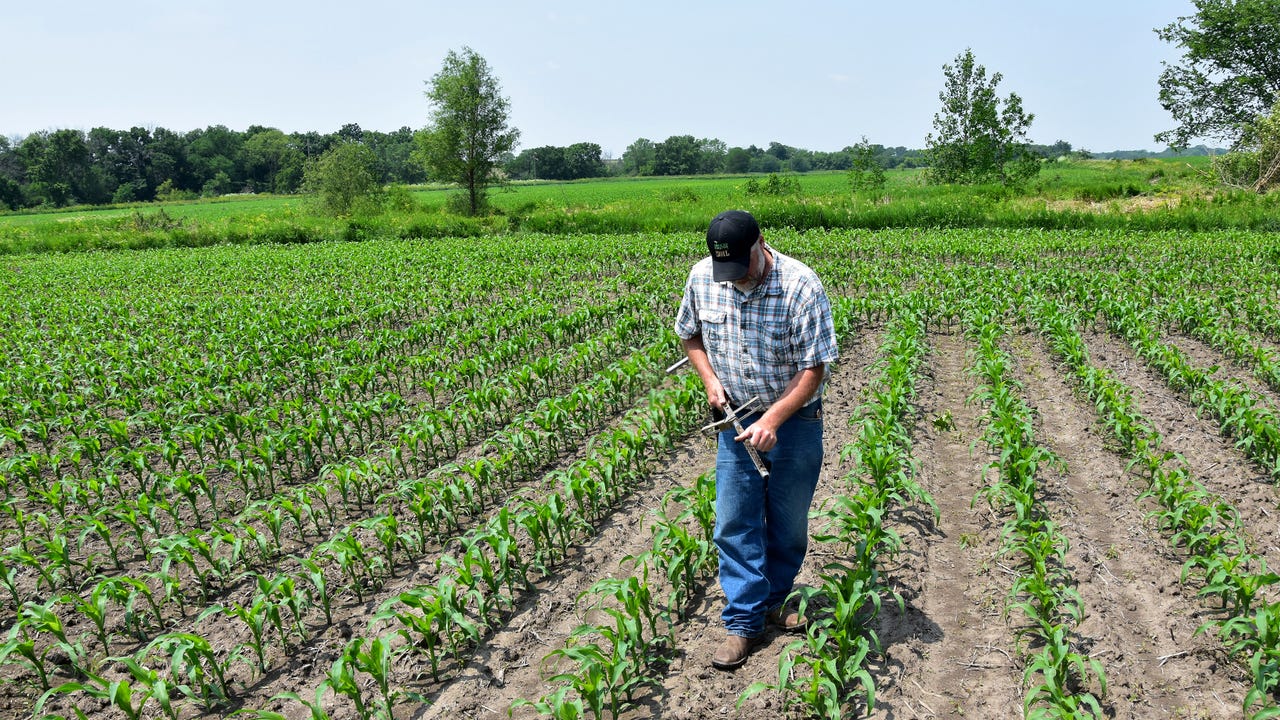Soil scientist — to many people — may sound like a less-than-exciting career choice. Digging around and looking at different soil identifiers such as colors, moisture levels and textures might seem a little boring.
But for the soil scientists across the country working for USDA’s Natural Resources Conservation Service, soil is exciting. To them, soil is literally and figuratively the foundation for many decisions made by farmers.
NRCS staff recently celebrated the agency’s 90th anniversary. Formed out of the Dust Bowl era, NRCS has — from its very infancy — focused on reducing soil erosion on private lands.
Case in point
Jason Steele is an NRCS area resource soil scientist who covers southeastern Iowa. He has been a soil scientist for NRCS in some capacity for almost 25 years. He grew up on a farm and still works there every night after work. His family raises corn, soybeans, alfalfa and pasture for their cow-calf operation.
“Since I actively farm, it helps me communicate well with our farmer landowners,” Steele says. “I can talk to farmers about planting, harvesting, haying, agronomic concerns and even economic scenarios. I feel that it builds trust between NRCS and our farmers.”
He says conservation — and production-related decisions on the farm — begins with the soil.
 ASSESSING SOIL MOISTURE: NRCS soil scientist Jason Steele uses a soil probe to assess soil moisture and other properties on a farm near Ainsworth, Iowa, this summer.
ASSESSING SOIL MOISTURE: NRCS soil scientist Jason Steele uses a soil probe to assess soil moisture and other properties on a farm near Ainsworth, Iowa, this summer.
“When I assist producers who may want to build a pond, for example, there are important decisions to be made,” Steele says. “First, are there good soils with adequate clay content? What is the pond going to be used for, livestock water? Or just to slow erosion and provide water-quality benefits? We discuss the best location for the pond with the landowner and the NRCS conservation planner to make sure we are covering up overfall points that lead to erosion.”
Although the agency has expanded its focus over the years, soil is still a major resource concern in Iowa.
“NRCS is much more than just about erosion control now, but we still feel strongly that soil health and sustainability are the heart of everything we do,” Steele says. “If we take care of the soil, we keep phosphorus and nitrogen from polluting our waters, and plants and crops grow much more naturally with high levels of organic matter.”
Investigating soils
A big part of Steele’s job involves investigating soils to see if practices such as wetlands, saturated buffers and grade-stabilization structures can be installed in a specific location.
“If I have a chance to work with producers to discuss the investigations, we may also chat about their farming methods and incorporating soil health practices, rotational grazing or [Conservation Reserve Program],” he says. “I try to explain the soil types on the landscape and how they can benefit from different practices.”
Steve Berger, who farms in Washington County, says Steele has been a resource for soil information and conservation practices for many years.
“Jason is very knowledgeable about soil science, and he has a lot of experience,” Berger says. “He explains it so I can understand it. I consider Jason a very good friend, having shared the stage with him for the last 13 years talking about how to improve soils and farming practices.”
As an experienced soil scientist, Steele shares his knowledge with new staff through field days and training workshops.
“I enjoy passing soils knowledge on to not only [NRCS and conservation partner] staff, but landowners,” he says. “Soils are very complicated, and repetition is always good, especially when we can do hands-on events in the field. I asked my soil mentors questions years ago, and I am still learning in my career.”

SOIL SAGE: NRCS soil scientist Jason Steele (kneeling) instructs a group of NRCS employees during soil health and sustainability training this summer near Ainsworth, Iowa.
“It is important for our employees to have a basic knowledge of the soil so they can explain to landowners what might be happening in their fields,” Steele adds. “When I give training, I always tell the employees to please ask questions. That is how we all learn.”
Amy Fischer, NRCS assistant state conservationist for field operations, says Steele is a huge asset for Iowa.
“Jason’s knowledge of the landscape and farming in southeast Iowa are utilized in all 24 counties within his area,” she says. “He supports conservation for not only NRCS programs but also for our state partners’ programs.”
Steele says he also enjoys recruiting new employees by speaking with high school classes or by giving presentations at colleges. “This job allows me to do soils judging for FFA contests,” he says. “I enjoy working with youth because they are the next generation to farm the land, and we must give them ideas about conservation at an early age.”
NRCS is a great place to work, Steele says, because he gets to help landowners put conservation on the ground.
“If you talk to most of my co-workers, they will say the same thing. We enjoy that aspect of the job most,” he says. “I like to give farmers different ideas to help them make their farms healthier and beneficial to water quality.”
For NRCS conservation planning assistance, visit your local USDA Service Center. Information also is available at nrcs.usda.gov/ia.